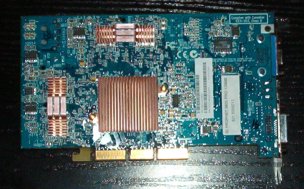|
I mentioned on the previous page that copper was the order of the day with Hercules' range topping 9800 Pro, here's some slightly shaky visual proof. Excuse my obvious lack of skills when behind the lens.
 This card lights up 8D
This card lights up 8D
With a copper main heatsink, remeniscent, in shape at least, of Sapphire's coolers on their high end Radeons, it certainly looks the part. The main heatsink also sneakily houses a blue LED that indicates when there's power to the card. While it's certainly criminal of me not to show what it looks like, it's not the brightest of LED's. In the dark, when working in the business end of a DFI Lan Party KT400A which has more red LED's than NVIDIA have had driver scandals, it wasn't overpowering. It's no substitute for any other kind of case lighting, whether that's a good thing or not is up to you.
The memory modules, front and back, get the copper treatment too. With each pair of ramsinks that share board space, there was a single bridged copper heatsink to cool them. So 4 memory ramsinks in total, 2 front and 2 back, cooling 8 discrete chips. There's also some more copper on the front side of the board, cooling some mosfets on the top left near the display outputs. I didn't pluck up the courage to have a poke when things were running, one assumes they do serve a purpose however.
The back side of the card is little different.
 More of the stuff normally found in old heating pipes
More of the stuff normally found in old heating pipes
The other pair of bridges ramsinks as mentioned earlier, plus another slab of copper that cools the back side of the GPU. Needed? Probably not, but who cares, it looks pretty good.
As you can imagine, the card comes in at a fair weight. Subjectively weighing up all the graphics cards I had to hand, one Herc 9800 Pro weighs about the same as a Radeon 9600 Pro and FX5600 Ultra combined. Excellent, at least you know you're getting what you paid so much for. Just block out the sounds of your AGP slot screaming for mercy. It's probably best to move the card seperately from your chassis, when transporting your PC.
Bundle contents
So what do you get in the box? A driver CD of course, featuring the 3.2 CATALYST's (at least on the CD I recieved), a few miscellaneous utilities, plus a full copy of Rainbox Six 3. I knew I should have kept those CD's before the card went back. All in all, a bundle worth your money, especially since you also get a DVI-to-VGA convertor for running a regular display from the DVI output, along with the usual compliment of S-Video cables and S-Video-to-Composite convertor cables. S-Video output is preferred when working with the TV-out, for greater image quality. For what it's worth, using the Hercules to watch DVD's on my television using S-Video looked great. YMMV on your own display hardware of course.
2D Image Quality
I haven't bothered talking about 2D quality on any recent cards I've looked at, simply because on anything that wasn't produced in the dark ages and isn't onboard a motherboard, usually looks great. The Hercules however looked just that little bit sharper than most and as such, merits a little footnote before we go crazy with a boat load of graphs. Simply excellent 2D from the regular VGA output, worth pairing with a high quality CRT without question.
|